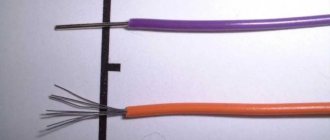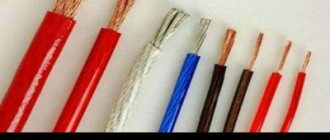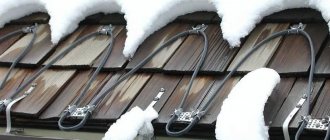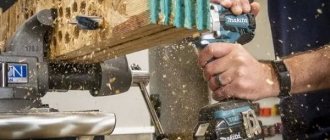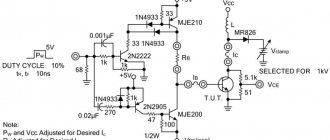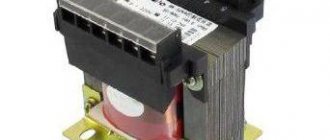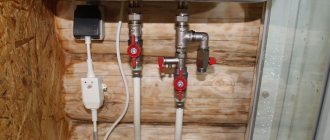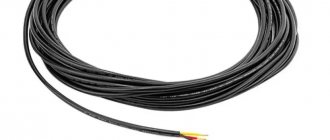Differences between PVS and VVG. Table 1
| Cable criterion/brand | PVS | VVG |
| Lived | Copper multi-wire | Copper mono- or multi-wire |
| Degree of core flexibility | High (grade 5) | Secondary (grade 1-2) |
| Number of cores | 2-5 | 1-5 |
| Core cross-section, mm2 | 0.75-2.5 | 1.5-625 |
| Winding | — | Non-woven fabric |
| Operating voltage, V | ||
| — alternating current (50 Hz) | 380 | 660/1000 |
| - direct current | 660 | 1600/2400 |
| Operating temperature, °C | -25 to + 40 | -50 to + 50 |
| Limit core heating temperature, °C | 70 | 80 |
| Service life, years | 6-10 | 30 |
The use of such cable brands as PVS or ShVVP, as a rule, does not go beyond the domestic sphere, which is facilitated by their increased flexibility (class 5), as well as the maximum operating voltage, which is limited to 380 V AC and 660 V DC.
The PVS connecting wire has proven itself to be an excellent extension cable, as well as when installed in special boxes or inter-device installation. The VVG brand meets the requirements of industrial standards and is distinguished by an extended operating temperature range, -50/+50 °C, and an impressive period of uninterrupted operation, up to 30 years, which allows the creation of durable permanent connections. VVG cable is allowed for installation in blocks and on special overpasses, on bridges and in mines, inside dry and damp rooms, incl. under concrete and plaster, in fire and explosion hazardous areas, on land and in water bodies, at an altitude of up to 4.2 km above sea level and in places with increased vibration.
We recommend reading:
Is it possible to build a house in 30 days and 1 million rubles?
Didn't find an article on a topic that interests you?
Just write a few words in the form at the top of the screen, our search will automatically select suitable articles.
All about country life and construction
Where is Moscow expanding? And what does this mean for summer residents? 586522 Will the Central Ring Road be able to relieve congestion on highways near Moscow? 328461 How to calculate acres of land? 272478 Which areas of the Moscow region are the cleanest and dirtiest in terms of ecology? 234517 Which metro stations will be built in the Moscow region? 210016
How much does it cost to connect a house and land to communications? 157596 Where is it better to live in the Moscow region? Rating of districts 127119 How many acres of land do you need to build a house? 124603 Districts of New Moscow. What are their advantages and disadvantages? 122332 What are the restrictions on construction near rivers and reservoirs? 106600 Which home heating is more profitable: gas or electric? 91610 Building codes and rules for the development of land plots 87137 What exhibitions of finished houses are there in Moscow and the Moscow region? 82492 The best cottage villages in the Moscow region 74987 What houses are currently on sale in the Moscow region? 71058 What are land plots without a contract? 63403 Are the basement and basement considered floors? 59357 Land development from scratch. Where to begin? 56364 Is it possible to leave SNT? 55216 What taxes must be paid for a house, garage, bathhouse and other buildings? 53086 How to re-register a plot? And how much does it cost? 54453 Is it profitable to build a house for sale? 49722 Where will the gas soon be? Gasification plan for villages in the Moscow region 46956 The best places for fishing in the Moscow region 45577 Pitfalls when buying a house
What should you pay attention to? 44219 How to bargain for a house? 43096 Life in a cottage community. Pros and cons 43039 Rating of Moscow region districts by quality of life 46061 Is it worth buying a house in SNT for permanent residence? 45718 Do I need to obtain permission to build a house on my site? 44080 Will a house built in SNT be considered residential? 42271 What to do after purchasing a plot? 38802 How long does it take to build private houses? 36443 The largest and most expensive cottages in Russia 35652 How much will it cost to build your own house? 34879
What is the best material to build a house for permanent residence from? 31842 How to register a rented plot under a house? 31209 Is it worth renting forest land for construction? 29013 How many floors can a cottage be built on? 28775 Ecovillages and ecovillages. What it is? 27789 What is the size of utility bills in cottage villages? 26705 How to build a house on a plot with a slope? 26152 Repair and decoration of a cottage. Work order and all stages 25583 Purchase of a plot with an unregistered house. What are the risks? 24136 Which private houses are warmer in winter? 23893 Division of a house with a plot. How to apply correctly? 23048 Gas to a private house. How to do it? 23048 How to rent out your plot? 22473 Turnkey house construction? Like this? And how much will it cost? 21681 Depreciation of the condition of the house. How to understand? How to calculate? 21108 Modular houses. What it is? 20520 How much will it cost to maintain your home? 20195 Lands of private household plots. What are their pros and cons? 19822 Forest areas (near the forest). What are their pros and cons? 19260 How to change the purpose of a site? 19127 Which is better: Cottage or Townhouse? 18830 Is it possible to turn a dacha into a residential building? 18564
Which cable, PVS or VVG, is better for an apartment?
The cable that comes from the distribution box to the apartment switchboard is usually one of the varieties of the three-core VVG brand.
We recommend that you read the article “Cable for laying in an apartment.”
When creating a stationary wiring for an apartment electrical network, it is better to use a VVG cable, due to a greater safety margin in terms of electrical and functional characteristics. However, when laying wires in boxes and baseboards, especially in places that require significant bending of the product, many electricians work with PVA. It should be taken into account that PVS can withstand less load than VVG and this is the indirect purpose of this wire, although there is no strict prohibition in the PUE for laying PVS wire in an apartment.
Designation according to GOST
First, let's decide on a name.
According to GOST 15845-80, this is what is meant by these cable products:
What is a wire? A wire is a conductor (solid or stranded) with insulation around the core in the shape of a tube. Some wires have no insulation at all.
For example, bare wires A (aluminum), AC (aluminum with a steel core), PS (steel wire), PSO (single-core steel wire).
A separate category is a relatively new type of wire - SIP (self-supporting insulated wire).
You can read in great detail about its characteristics, brands and differences in the article below.
A cable is already several insulated conductors connected into one structure. The cables have a double layer of insulation.
The insulation of the conductor itself, plus the insulation on top of all the cores. The second insulation can be from:
- place class=”aligncenter” width=”500″ height=”244″[/img]
- rubber or caoutchouc
- metal
- XLPE – cross-linked polyethylene
The most modern brands are cables made of cross-linked polyethylene.
That is, roughly speaking, it turns out that a cable is several wires combined under one protective sheath. If there is no more insulation on 2 or 3 conductors, even twisted together, then this is a wire.
Which brand, PVA or VVG, is better for the home?
The power supply diagram of a house, in particular a wooden one, has a number of specific features, for example, a relatively large length of wiring, the need for outdoor cable laying and its entry into the house, etc.
To enter the house, use a VVG cable with a cross-section of 16 mm2 in a metal pipe.
More detailed information in the article “Cable for a wooden house”
For internal hidden wiring in a wooden house, it is necessary to lay the cable in metal pipes. The best option is the VVG cable; PVS is not prohibited, but let us remind you that its main purpose is for non-stationary installation.
For internal open wiring on insulators or in a cable duct, you need a non-flammable cable marked -ng, for example, VVGng.
Insulation properties for electrical wiring:
non-flammable,
reduced smoke and gas emissions,
increased fire resistance,
does not emit corrosive gaseous products during combustion and smoldering,
with low toxicity of combustion products.
detailed description.
Detailed description of fire safety abbreviations
Internal electrical networks must be flame retardant and made of cables and wires with conductors made of copper or aluminum alloys of grades 8030 and 8176, busbars with copper busbars in accordance with electrical and fire safety.
Which brand, PVS or VVG is better for the street?
PVC insulation and sheathing of the VVG brand are characterized by increased resistance to the corrosive influence of the environment, the product is not afraid of low and high temperatures, as well as their sudden changes, and is well resistant to direct sunlight, but when protected from the sun by corrugation, it will last much longer. In principle, VVG is suitable for stationary open street wiring.
More detailed information about outdoor cable laying in the article “Cable for the street”
The shell material of PVA and VVG is the same, so the UV resistance is similar. PVS wire is used for street carrying and connecting mobile electrical equipment on the street; its service life during active use is no more than 3-5 years. At temperatures below -25 C, due to the small thickness of the insulation, the PVA wire becomes tanned and may crack.
Application area
Extensions or carriers
The main area of application and purpose of the conductors discussed are extension cords. Moreover, if the extension cord will be used in difficult conditions (at a construction site, in a garage to connect power tools), it is better to choose PVS wire
In this case, frequent kinks and random impacts and friction are typical, so it is important that the conductor has high-quality and thick insulation
If the extension cord will be laid somewhere behind furniture or in another way, where the likelihood that it will be crushed or other damage will occur is minimal, then it is quite possible to choose a ball screw cord. It will be more convenient to lay it or place it in narrow places due to its smaller size. Such extension cords are used when the outlet is located in an inconvenient place, as well as to connect several electrical appliances installed in one place, for example, a TV, media player and speaker system.
Let's talk about what is better for an extension cord: PVS or ShVVP wire. Generally speaking, PVA extension cord is used where frequent impacts or damage are likely. It is also better suited for connecting powerful electrical equipment, for example, hammer drills, grinders, or even some technological devices such as heat guns, provided that there is no direct contact of hot air flows or parts of the device with the wire itself.
ShVVP are used for those extension cords that do not connect powerful devices. They are better suited for connecting small kitchen equipment, lamps, electric shavers and consumer electronics.
We talked about how to make an extension cord with your own hands in the article. Check out the material to make a reliable extension cord for connecting household appliances.
Lighting and wiring
Since hidden and open wiring are stationary electrical installations, neither a wire nor a cord fits this definition. In contrast, a cable with single-wire conductors of the VVGng type is specially designed for use in wiring. Nevertheless, the question often arises: “Is it possible to use SHVVP or PVS for wiring or lighting?” Their use is not recommended for main wiring and connection of socket groups.
The outer shell of SHVVP is thin enough to be installed in a wall, although this can be corrected by laying it in PVC corrugation
At the same time, although PVA has a thick layer of insulation, there is an interesting opinion that this will make it difficult for conductive conductors to transfer heat to the environment, which is especially important when hidden under plaster
When connecting spotlights in a suspended ceiling, the wires are laid behind the plasterboard sheet, and if the ceiling is suspended, then along the surface of the rough ceiling. Due to the variety of design solutions for installing lighting points along curved contours, it will be more convenient to use wires with flexible cores. In these cases, it will be convenient to choose ShVVP or PVS. But from the point of view of durability and mechanical strength, in this case PVA is better suited.
Outdoor installation is allowed only in PVC corrugation, and the operating temperature range of PVC wire is better suited for this purpose.
Finally, we recommend watching a useful video on the topic of the article:
We looked at the differences between SHVVP and PVS and advice on which one to choose for specific tasks. But we would like to remind you that the connection of these wires must be carried out using terminal blocks with a spring clamp (VAGO type), soldering, welding, or sleeves. Twisting is strictly prohibited, and when clamped with a screw (as in sockets), the wire strands begin to tear, causing poor contact. Over time, it will warm up or burn out altogether.
Which brand, PVA or VVG, is better to use for connecting stoves and other household appliances?
Connecting household electrical appliances is usually done by bending the cable multiple times. In addition, there is a possibility of pinching and stretching of connecting and extension cords. Therefore, to connect household electrical appliances, it is better to use the PVS cable brand.
Read our article “Cable for electric stove”
Accepted colors
The above GOST does not impose any special requirements for the coloring of external insulation; 10 color options are allowed: white, black, gray, etc.
As for the color of the core insulation, it must correspond to the table below.
The color chart for insulation is live depending on their purpose and quantity:
| Number of cores | Accepted color standard | |
| there is a grounding conductor | No grounding conductor | |
| 2 | brown, blue | |
| 3 | yellow-green, brown, blue | black, brown and blue |
| 4 | yellow-green, black, brown, blue | blue, black, brown, black or brown |
| 5 | yellow-green, blue, black, brown and black or brown | blue, black, brown, black or brown, black or brown |
The purpose depending on the color of the insulation is shown in Figure 3.
Colors according to GOST for neutral, protective and phase conductors
Please note that sometimes the insulation of the phase conductor is also white, which is acceptable according to the international standard.
Having finished with the design features and color designation, let's move on to the description of the main parameters.
What is the difference between NYM and VVGng
Here are the main differences between the two cable brands:
firstly it has triple insulation
The third intermediate layer, in addition to fire-fighting properties, also restrains mechanical stress between the external insulation and the conductors. This prevents the formation of cracks on them.
True, the manufacturer himself does not consider this third layer of extruded rubber mixture to be insulation. And judging by the test voltage, the insulation itself is somewhat inferior here:
- VVGng – test voltage – 3 kV
- NYM – test voltage 2.5 kV
secondly, its insulation is gray, while that of VVG is black
For many, categorically black may not be suitable for aesthetic purposes.
thirdly, it is always round in shape
A plus that few people think about, but the rounded shape of NYM makes it easier to seal the input of this cable into various devices, junction boxes and cabinets.
and most importantly, the NYM cable is suitable for fire safety for indoor premises only when installed individually!
If you want to lay it in bunches of two or three pieces in one groove or channel, you will have to use the NYMng (A)-LS modification. Just don’t be confused, single NYMs, each laid in a separate corrugation, and running along the surface of a wall or ceiling next to each other, are not considered a bundle. This is exactly how many electricians get around the ban on group installation of wiring of this brand.
Technical characteristics and operating conditions
According to the current GOST, this type of wire must meet the following standards:
- The lower limit of the operating temperature range is 20°C below zero, permissible long-term heating is 40-50°C, short-term heating is not more than 70°C. Frost-resistant design is possible, in this case the lower threshold drops to -40°C.
- The rated voltage is 380 V, but the insulation must withstand a short-term increase of up to 2000 V (at least 5 minutes). It is under these conditions that tests should be carried out by the manufacturer.
- PVA insulation of any type should not spread fire if a single installation was carried out. When laying in groups, this requirement applies only to wires marked “ng” in the marking.
- Failure-free operating time in hours is at least 5000; when used in stationary installations, this parameter increases to 12000; in years this is 6 and 10 years, respectively.
- The threshold of permissible relative humidity should not be lower than 98%.
- Mandatory resistance to the destructive effects of fungi and mold.
The remaining parameters are shown in the table below.
